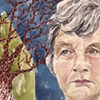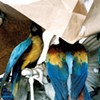Published April 7, 2004 at 1:25 p.m.
According to ancient European legend, a flock of waxwings is a harbinger of disaster. The lovely little songbirds were thought to foreshadow war, pestilence and every manner of social chaos. Here in Vermont they're generally considered a sure sign of spring, although they will stay year 'round as long as the living is easy.
This past winter was apparently easy enough for Vermont's waxwings, despite subzero temperatures, because they seem a little friskier than usual. So much so that, since late March, Fletcher Free Library custodian Douglas Chamberlain has had a bigger problem than in recent years: birds and large windows just don't mix. Chamberlain solved his conundrum by creating an unlikely, and unwitting, temporary piece of art.
Monday, March 29, began as a clear morning in Burlington, and Chamberlain was on the job as dawn's early light illuminated the Queen City. But he wasn't alone at the library that morning. A flock of Bohemian waxwings was already getting rowdy just outside. The library grounds have flowering crab-apple trees, and waxwing autopsies have shown that the little chirpers actually become intoxicated by eating fermented fruits on such trees.
Thus, a Bohemian waxwing bacchanal was well underway. They were singing and getting drunk in the crab-apple trees like there was no tomorrow. For some of them, that was all too true. At 7:15 a.m. the first reveler body-slammed a library window.
There are two types of waxwings in Vermont: Cedar (Bombycilla cedrorum) and Bohemian (Bombycilla garrulus). Both share the genus Bombycilla, and while the birds might think that's Latin for "bomb the window sills," it actually translates into "soft tail." The Cedar species is more common in New England, but Bohemians have been seen with greater frequency this year than in previous years. The latter are usually evident further west, and they are also the dominant waxwing in Europe.
Both varieties posses a modest crest of feathers atop their heads, black around their eyes that makes them look like masked bandits, and translucent, waxy-looking wing feathers. The Cedars also have a more cinnamon body coloring, while the foppish Bohemians sport pale orange highlights on their heads and tails. Eyewitness reports say the library is a favorite haunt for Bohemians.
Friends shouldn't let friends fly drunk, but the gregarious waxwings didn't seem to care last week. By early afternoon on the 29th, about 20 birds were casualties. The carnage was heartwrenching. Children cried at the sight of the crumpled creatures. Some library patrons forlornly tried to save the injured, while others brought dead birds home to give them a decent burial. All Chamberlain could do was clean up the mess.
Well, that wasn't quite all. In desperation, he contacted the Green Mountain Audubon Society, where Jennifer Gilson answered the call. Chamberlain thought he was speaking to a genuine ornithologist, but Gilson is actually the office manager. Nevertheless she's "very knowledgeable" -- after all, she fields a lot of bird calls. Chamberlain was pleased to hear Gilson's creative idea about how to save the library waxwings.
In previous years, he had tried putting up hawk silhouettes in the windows, but the results were poor. Gilson suggested instead hanging shiny things and objects that could sway in the breeze. The reflected light and erratic movement, she said, should be enough to warn the birds.
Chamberlain set off on a scavenger hunt -- a mission of mercy, really -- to find stuff to hang off the roof. Even public libraries are swamped with free AOL CDs, so the discs figured prominently in his plan. He also located chunks of Styrofoam and a length of yellow plastic ribbon that read "caution" to warn the birds. Not satisfied with the quantity and quality of materials immediately on hand, the intrepid Chamberlain rushed out to a local dollar store, where he purchased aluminum pie plates and a foil banner that read "just married."
Chamberlain tied those items together on long strings and scaled the roof to suspend them over the fatally attractive windows. Never have so few worked so hard to save so many drunken songbirds.
The pie plates, CDs, streamer and chunks of Styrofoam perform in a way that recalls Jean Paul Sartre's 1946 description of Alexander Calder's mobiles: "No human brain, not even their Creator's, could possibly foresee all the complex combinations of which they are capable." In Chamberlain's case that is completely true. He never even thought of the construction as art, and he seems surprised that any one else should.
But in a slight breeze, Chamberlain's installation has a wonderful kinetic energy. On a sunny day, reflected light is thrown around the library lawn and entrance like the flashes of a glitter ball at a grand cotillion. Instead of shedding tears over wounded and dying birds, children can be seen chasing dots of light over the grass. On cloudy days, when the reflections are minimized, even inebriated birds are not so tricked by glass. Since the installation was put up, relatively few birds have been lost.
Other locations in the area might want to try similar waxwing deflectors. Chamberlain has heard that IBM in Essex Junction and Champlain College in Burlington both have big windows and bird-collision issues. Hawk silhouettes were formerly posted in the windows of the Firehouse Gallery facing City Hall Park, but stoned waxwings have been less problematic there lately, perhaps in part because of recent renovations.
Any place with flowering crab-apple trees is a potential hot spot for waxwings. A prominent copse in front of Great Harvest Bread Company on Pine Street is one frequented locale, but company co-owner Sara Brown reports that the birds are simply beautiful and not a problem at all. Not yet, anyway.
There are no 12-step programs for these diminutive alkies, and as long as sources of fermented fruit are within beak range, these birds will imbibe. Chamber-lain looks forward to the day when the flowering crab-apple trees in front of the library are history, replaced with species that don't bear such irresistible fruit. The trees are ailing and may not be around much longer. When they're gone, so too will be the reckless waxwings, and perhaps this custodian-cum-artist will get to hang up his beret.
More By This Author
Speaking of...
-

Q&A: Catching Up With the Champlain Valley Quilt Guild
Apr 10, 2024 -

Video: The Champlain Valley Quilt Guild Prepares for Its Biennial Quilt Show
Apr 4, 2024 -

Q&A: Meet a Family in Waterbury That Embraces Halloween Year-Round
Feb 14, 2024 -

Video: Goth Family in Waterbury: Sarah, Jay and Zarek Vogelsang-Card
Feb 8, 2024 -

Q&A: A Clinic Has Cared for Old North End Pets for Almost 20 Years
Jan 31, 2024 - More »
Comments
Comments are closed.
From 2014-2020, Seven Days allowed readers to comment on all stories posted on our website. While we've appreciated the suggestions and insights, right now Seven Days is prioritizing our core mission — producing high-quality, responsible local journalism — over moderating online debates between readers.
To criticize, correct or praise our reporting, please send us a letter to the editor or send us a tip. We’ll check it out and report the results.
Online comments may return when we have better tech tools for managing them. Thanks for reading.














































